Latin name: Phalaenopsis
Category: epiphytic herbaceous plants
Birthplace: Indonesia, Malaysia, Philippines, Australia
Phalaenopsis - spectacular and luxurious butterfly orchid
Phalaenopsis (Phalaenopsis) is represented by bright, refined, exclusive, sophisticated, attractive herbaceous crops that adorn the Orchid family with their presence.
Seventy varieties of plants, absolutely different from each other, fit into the community of these unique ones. The main company of phalaenopsis are epiphytic inpiduals, the dominant life activity of which takes place in collaboration with large plants, located on their trunks and twigs. A smaller lithophytic grouping of phalaenopsis is located more on rocks or on the ground.
The phalaenopsis orchid has chosen wet mountainous and flat forests of Southeast Asia, Northeast Australia as its native natural territories, it can be found in the Philippines.
How did flower growers get such beauty? The first acquaintance of Europeans with phalaenopsis occurred thanks to the Dutch botanist, biologist, collector and naturalist with German ancestry Georg Rumfu back in the seventeenth century.
Traveling to the islands of the Indonesian group called the Moluccas or the islands of spices, he met this natural unique when visiting the island of Ambon. So this wonderful plant appeared in the Old World and was called by Carl Linnaeus Epidendrum lovely or in translation “growing on a tree”.
But the real name Phalaenopsis has become familiar to a wonderful flower since one thousand eight hundred and twenty-five. This name was given to the flower by the director of the Leiden University Botanical Garden, Karl Blume, after visiting the island of Ambon and meeting with another orchid of the same variety. In the twilight jungle, he was fascinated by flocks of white butterflies, which were actually unique flowers of an unfamiliar "moth-like" plant. It is thanks to such a mistake that this genus of orchids is currently called phalaenopsis.
If we consider the name of the flower according to two Greek phrases, it will look like this. "Phalania" - night butterfly, "opsis" - similarity. The plant also has other names - the Malay flower, the butterfly orchid.
And so the question arises: what is the difference between an orchid and a Phalaenopsis? Orchids unite by their name a huge community of plants, which is composed of five subfamilies, seven hundred and thirty genera and twenty-four thousand varieties of plants. This association includes the genus Phalaenopsis.
For this reason, there should be no visible differences between the phalaenopsis and the orchid. After all, they have one biological chain, and they themselves are its separate links.
What are phalaenopsis?
The plant has a wonderful basal rosette in the form of a small herbaceous bush, which is organized by oblong, juicy and plump leaf blades with a two-row arrangement, emerging at the base of the flower and smoothly turning into roots. Under natural conditions, the roots receive enough light, air space and moisture in the form of rain water. The bark of trees is the food and the acquisition of all useful substances for phalaenopsis, thanks to the green air roots.
In the spring and summer, the phalaenopsis orchid is transformed by the appearance of one or more peduncles with wonderful butterfly flowers up to fifty pieces. The shape of the inflorescences is cystic. The number and size of the flower from two centimeters to fourteen in different varieties is inpidual. In nature, phalaenopsis flowers are white. Thanks to the constructive work of breeders, homemade butterfly orchids have a variety of colors. The biggest demand among flower growers still belongs to white and pale pink orchids.
Phalaenopsis can be pided into two groups. Some of them can reach a meter height, and the second subgroup are mini-phalaenopsis with a height of up to thirty centimeters.
Phalaenopsis varieties
Phalaenopsis Sunset Love
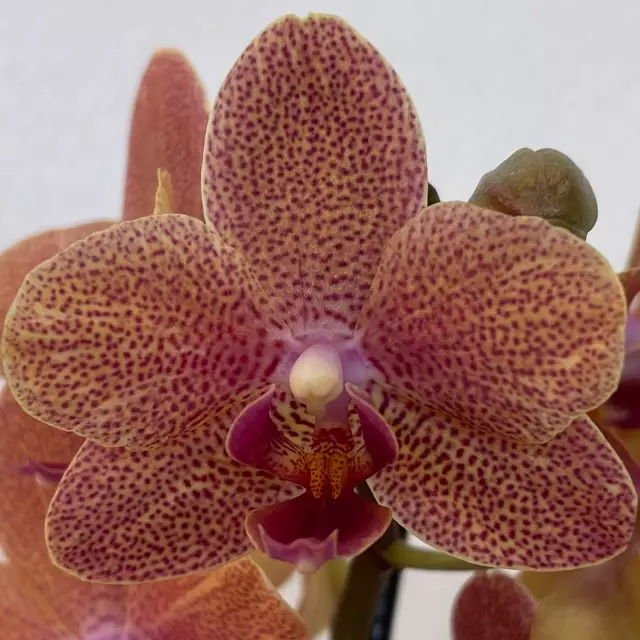 This hybrid belongs to the multi-flowered orchids Multiflora. The bush reaches forty centimeters in height with dense, dark green leaves and flowers up to eight centimeters in diameter. The petals are orange-gold speckled with red, and the lip is a bright pink-red. The presence of this beauty organizes a real holiday for others.
This hybrid belongs to the multi-flowered orchids Multiflora. The bush reaches forty centimeters in height with dense, dark green leaves and flowers up to eight centimeters in diameter. The petals are orange-gold speckled with red, and the lip is a bright pink-red. The presence of this beauty organizes a real holiday for others.
Phalaenopsis Cleopatra
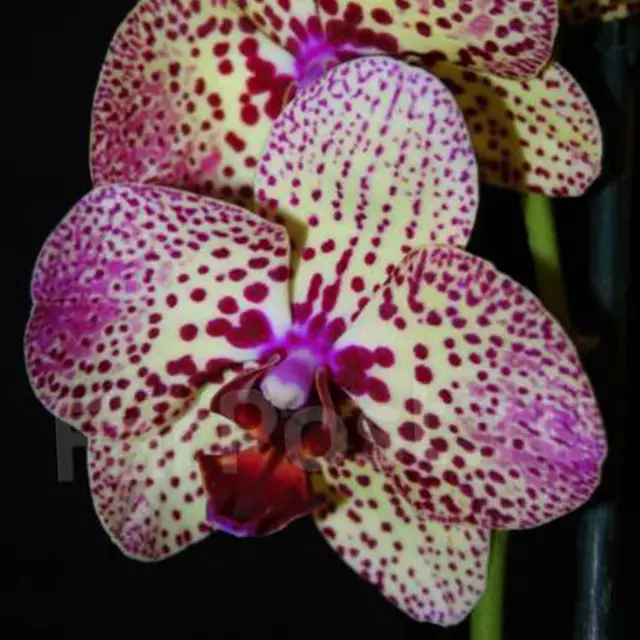 The main distinguishing feature of the variety is the rare color of the buds, which is not repeated on any of them. The flowering period of the plant is very long. The predominant color is yellow-white and white.
The main distinguishing feature of the variety is the rare color of the buds, which is not repeated on any of them. The flowering period of the plant is very long. The predominant color is yellow-white and white.
Phalaenopsis Horizon
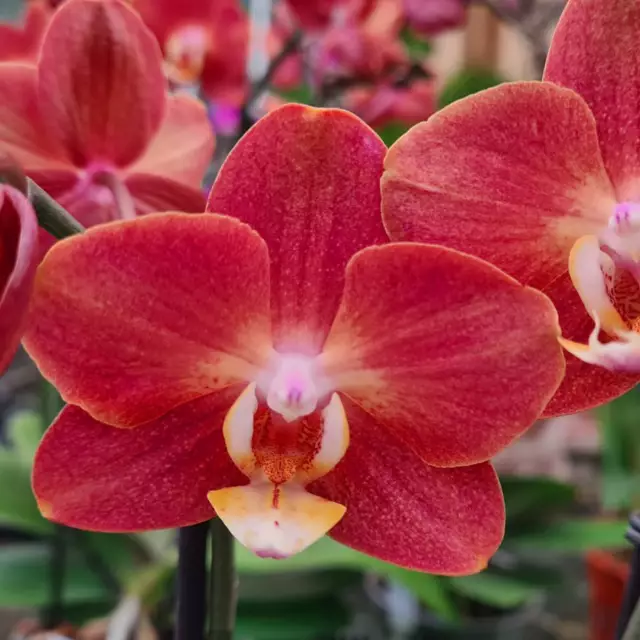 A hybrid variety with fleshy, bright green oblong obtuse leaves. From the leaf axils, the plant acquires straight branching peduncles, densely strewn with rounded or star-shaped butterfly flowers of a reddish-peach color. Artificially, the configuration of the peduncle is beautifully rounded for greater originality of this orchid.
A hybrid variety with fleshy, bright green oblong obtuse leaves. From the leaf axils, the plant acquires straight branching peduncles, densely strewn with rounded or star-shaped butterfly flowers of a reddish-peach color. Artificially, the configuration of the peduncle is beautifully rounded for greater originality of this orchid.
Phalaenopsis Legato
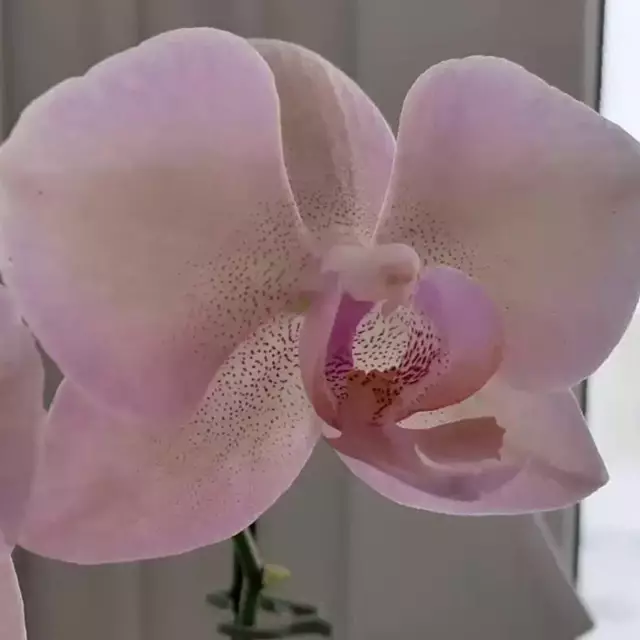 This original butterfly has large seven-centimeter flowers of pink, lilac, gold colors and a small number of leaves. A multi-flowered and long-blooming orchid grows up to seventy centimeters. Every year new peduncles, twigs and a large number of flowers appear on the plant. The name legato is translated from Spanish as smooth, fused, connected, which gives a description of the flowers of this variety.
This original butterfly has large seven-centimeter flowers of pink, lilac, gold colors and a small number of leaves. A multi-flowered and long-blooming orchid grows up to seventy centimeters. Every year new peduncles, twigs and a large number of flowers appear on the plant. The name legato is translated from Spanish as smooth, fused, connected, which gives a description of the flowers of this variety.
Phalaenopsis Phantom
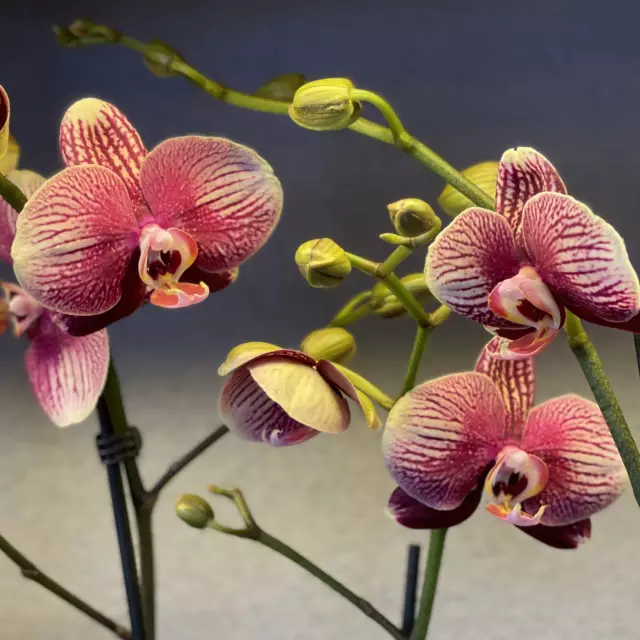 The English interpretation voices the varietal name "ghost", "phantom". And the orchid looks great, forming about eight glossy, oval leaf plates. There can be up to four peduncles on a bush at the same time. The duration of the flowering period is from three to six months. Petals of white, milky or light beige color are covered with a mesh, striped pattern, the shades of which can be cherry or raspberry. Burgundy-red lip emphasizes the originality of the flower.
The English interpretation voices the varietal name "ghost", "phantom". And the orchid looks great, forming about eight glossy, oval leaf plates. There can be up to four peduncles on a bush at the same time. The duration of the flowering period is from three to six months. Petals of white, milky or light beige color are covered with a mesh, striped pattern, the shades of which can be cherry or raspberry. Burgundy-red lip emphasizes the originality of the flower.
Phalaenopsis Stone Rose
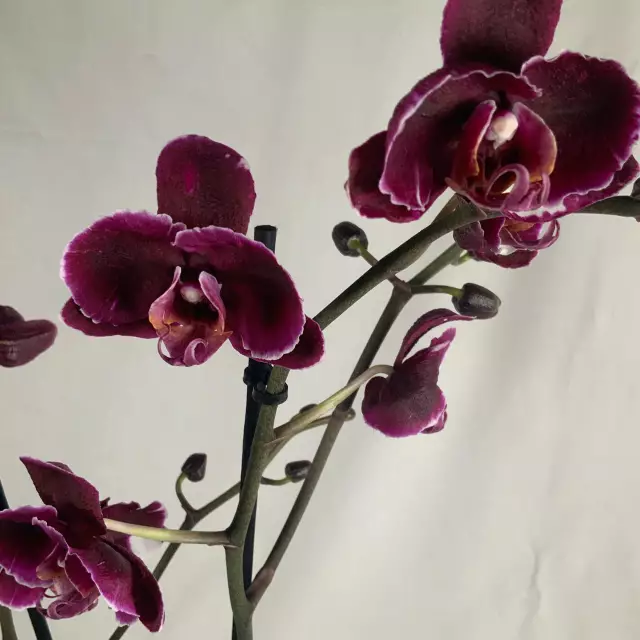 A very rare and capricious Phalaenopsis variety brought from an Indonesian island by a Swedish pastor back in the eighteenth century. As a result of the research carried out by Carl Linnaeus, another variety of phalaenopsis was described, called the Stone Rose. The shape of the flowers resembles a rose, and the spectacular dark crimson color with white veins makes the petals marble. This unusual beauty makes it possible for the plant to decorate any collection, the interior of apartments and office premises.
A very rare and capricious Phalaenopsis variety brought from an Indonesian island by a Swedish pastor back in the eighteenth century. As a result of the research carried out by Carl Linnaeus, another variety of phalaenopsis was described, called the Stone Rose. The shape of the flowers resembles a rose, and the spectacular dark crimson color with white veins makes the petals marble. This unusual beauty makes it possible for the plant to decorate any collection, the interior of apartments and office premises.
Phalaenopsis Frontera
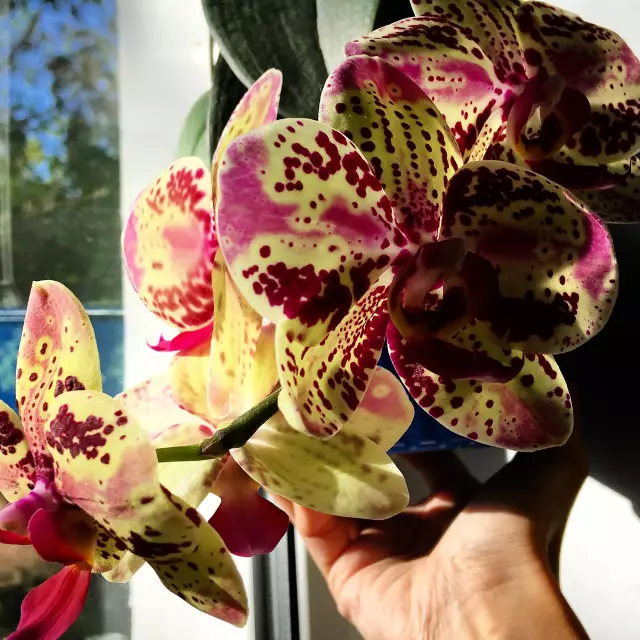 Represented by a luxurious large-flowered hybrid orchid with amazingly beautiful delicate, bright pink, burgundy or yellow buds. The exclusivity of the dotted ornament on the upper and two lower side petals makes the bud charming.
Represented by a luxurious large-flowered hybrid orchid with amazingly beautiful delicate, bright pink, burgundy or yellow buds. The exclusivity of the dotted ornament on the upper and two lower side petals makes the bud charming.
Phalaenopsis Lewis Berry
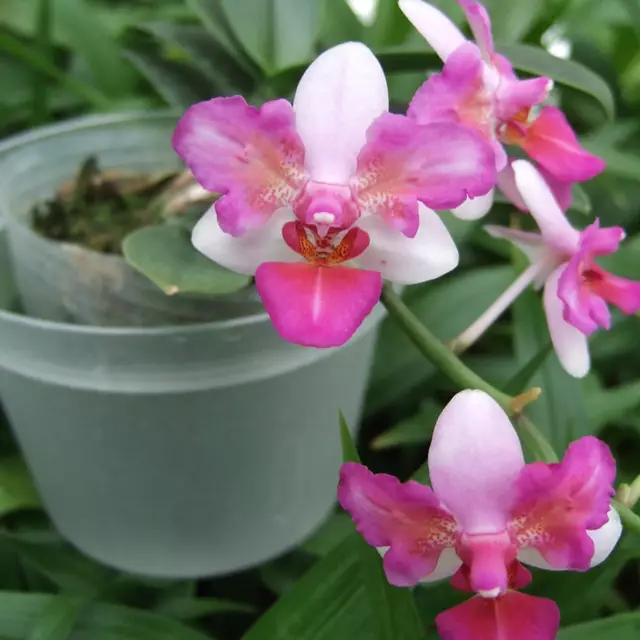 Australia considers this variety of phalaenopsis to be its homeland. Its uniqueness is in its beautiful lush, medium-sized, dark green leaf plates. On a thirty-five-centimeter bush, many peduncles are formed with small three-centimeter flowers. The color scheme is varied, from pink to dark lilac tones. The central part of the bud is burgundy, purple or blue. The beauty of flowering phalaenopsis Lewis Berry is enjoyed with pleasure twice a year with a flowering period of up to four months.
Australia considers this variety of phalaenopsis to be its homeland. Its uniqueness is in its beautiful lush, medium-sized, dark green leaf plates. On a thirty-five-centimeter bush, many peduncles are formed with small three-centimeter flowers. The color scheme is varied, from pink to dark lilac tones. The central part of the bud is burgundy, purple or blue. The beauty of flowering phalaenopsis Lewis Berry is enjoyed with pleasure twice a year with a flowering period of up to four months.
Phalaenopsis Dusty Belle
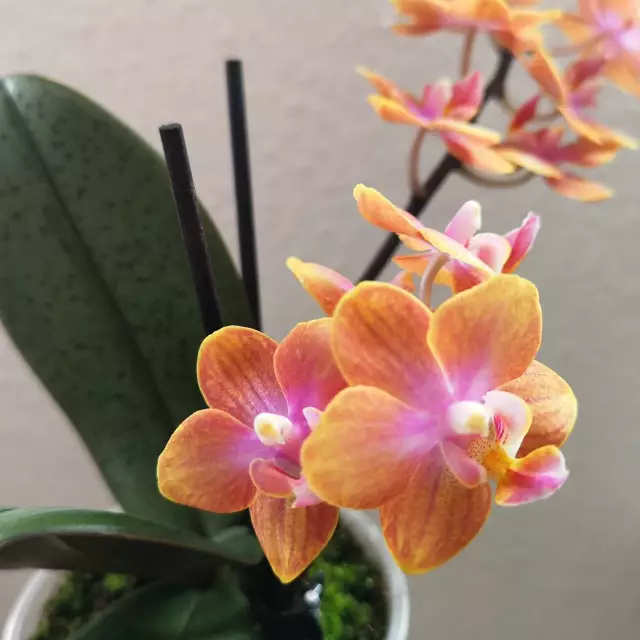 A very beautiful fragrant variety with a color similar to a dusty rose with golden rims on the edges of the petals. The variety of shades goes off scale from coral, pink, lilac tones.
A very beautiful fragrant variety with a color similar to a dusty rose with golden rims on the edges of the petals. The variety of shades goes off scale from coral, pink, lilac tones.
Phalaenopsis Ambiance
 Very interesting rare variety with pure white very original flowers.
Very interesting rare variety with pure white very original flowers.
Phalaenopsis African Sunset (Phalaenopsis Lottery Prince)
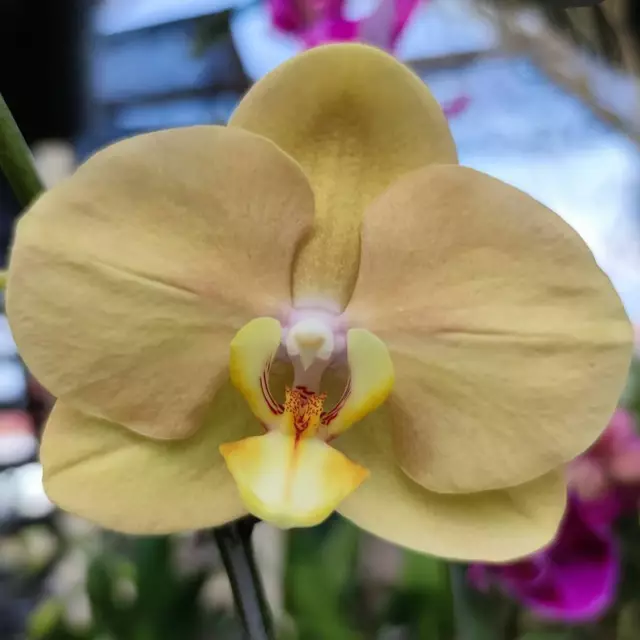 This variety is considered to be the most hardy, refined and colorful of all orchids. The color scheme of the petals with falling cascades reflects the palette of the wondrous sky. This combination with smooth, well-structured, green leaf plates assembled into an original rosette will decorate any interior.
This variety is considered to be the most hardy, refined and colorful of all orchids. The color scheme of the petals with falling cascades reflects the palette of the wondrous sky. This combination with smooth, well-structured, green leaf plates assembled into an original rosette will decorate any interior.
Phalaenopsis Kimono
 A delicate beautiful orchid with dense, glossy cherry, amaranth or purple flowers, and her burgundy lip has managed to win the hearts of flower growers all over the world. Juicy, thick, dense leaf plates have an emerald hue.
A delicate beautiful orchid with dense, glossy cherry, amaranth or purple flowers, and her burgundy lip has managed to win the hearts of flower growers all over the world. Juicy, thick, dense leaf plates have an emerald hue.
Phalaenopsis Ferrara
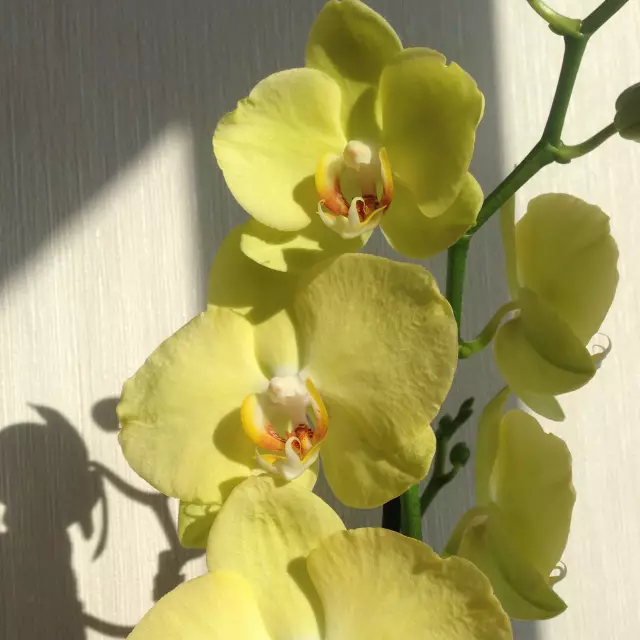 A distinctive feature of this variety is its original yellow color of even or slightly wavy petals that emit a delicate aroma. With proper care, lush flowering large flowers can be admired throughout the year.
A distinctive feature of this variety is its original yellow color of even or slightly wavy petals that emit a delicate aroma. With proper care, lush flowering large flowers can be admired throughout the year.
Phalaenopsis Pirate Picotee
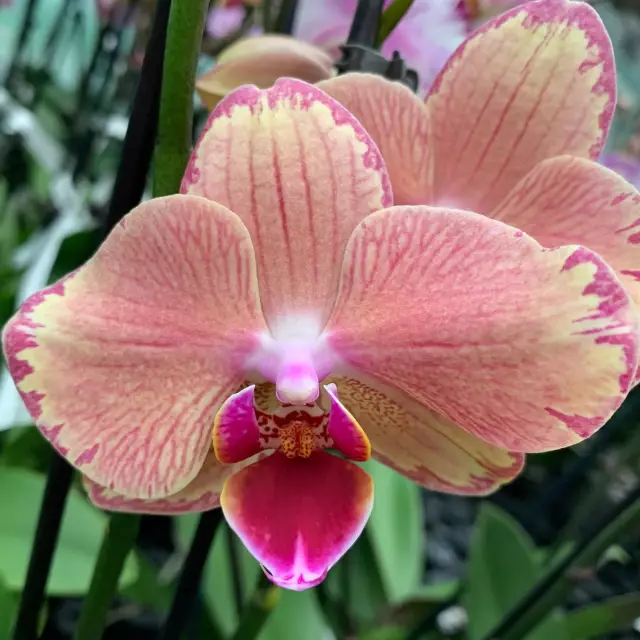 A very hardy, unpretentious and spectacular variety with a beautiful rosette formed by fleshy, elastic, rounded dark emerald leaves. It blooms with seven-centimeter delicate flowers of pink-yellow color with a cherry edging. The middle of the flower is dotted with speckles, and it has a bright crimson lip.
A very hardy, unpretentious and spectacular variety with a beautiful rosette formed by fleshy, elastic, rounded dark emerald leaves. It blooms with seven-centimeter delicate flowers of pink-yellow color with a cherry edging. The middle of the flower is dotted with speckles, and it has a bright crimson lip.
Phalaenopsis Jaguar
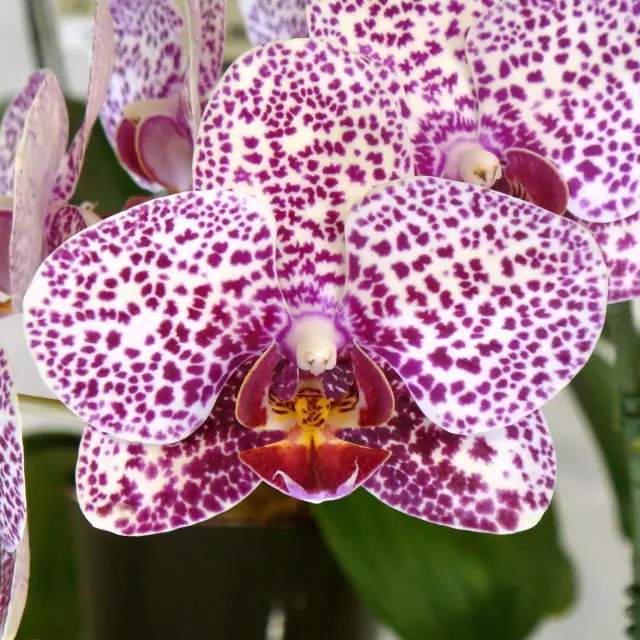 It is presented in the most original and spectacular way. The sinuses of bright green, fleshy, oblong, blunt leaf plates are a springboard for the formation of straight peduncles, the tops of which branch in an original way. They grow a lot of rounded or star-shaped butterfly flowers. Petals have a velvety texture with variegated coloration, lilac or purple patches and veins. Such beauty is similar to the color scheme of fuchsia.
It is presented in the most original and spectacular way. The sinuses of bright green, fleshy, oblong, blunt leaf plates are a springboard for the formation of straight peduncles, the tops of which branch in an original way. They grow a lot of rounded or star-shaped butterfly flowers. Petals have a velvety texture with variegated coloration, lilac or purple patches and veins. Such beauty is similar to the color scheme of fuchsia.
Phalaenopsis Philadelphia
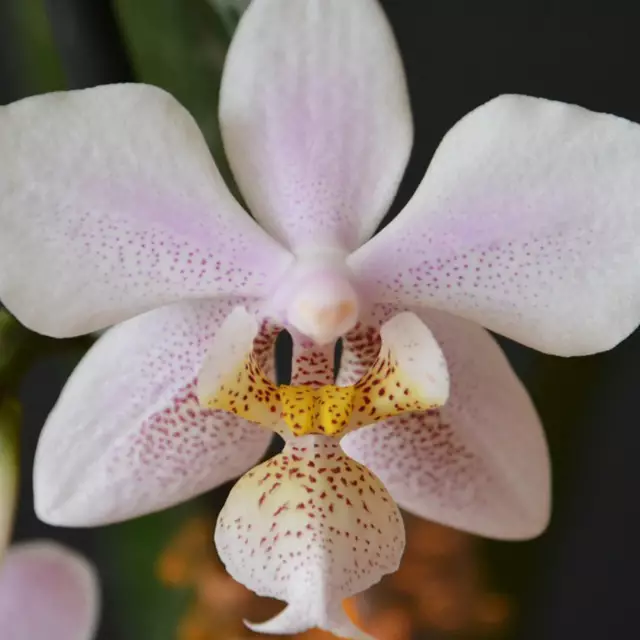 A very interesting hybrid look with dark green leaf plates, the underside of which is purple. A huge number of medium-sized flowers make the plant charming. The original white petals have a pink-lilac tint and are covered with contrasting brown-burgundy patches. On the lip, resembling horns, yellow spots and bright purple spots are scattered.
A very interesting hybrid look with dark green leaf plates, the underside of which is purple. A huge number of medium-sized flowers make the plant charming. The original white petals have a pink-lilac tint and are covered with contrasting brown-burgundy patches. On the lip, resembling horns, yellow spots and bright purple spots are scattered.
Phalaenopsis Narbonne (Phalaenopsis Anthura Narbonne)
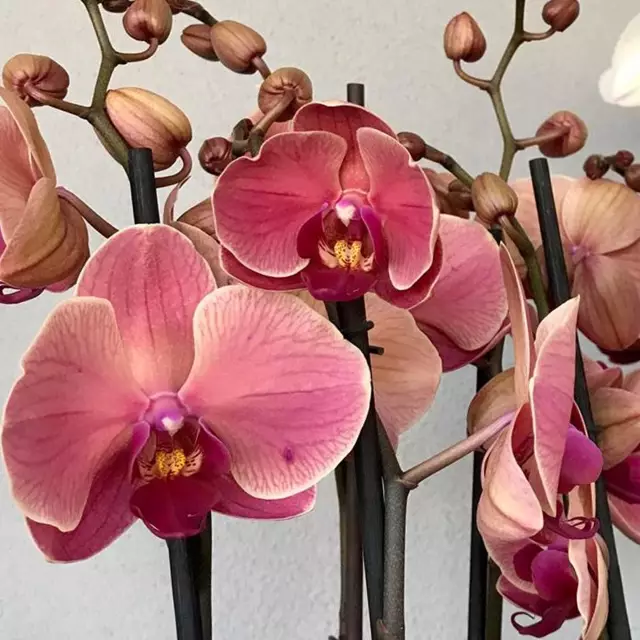 Has dark green leaves. Petals at Narbonne salmon, coral, tomato, terracotta shades. In height reaches sixty centimeters.
Has dark green leaves. Petals at Narbonne salmon, coral, tomato, terracotta shades. In height reaches sixty centimeters.
Phalaenopsis Ravello
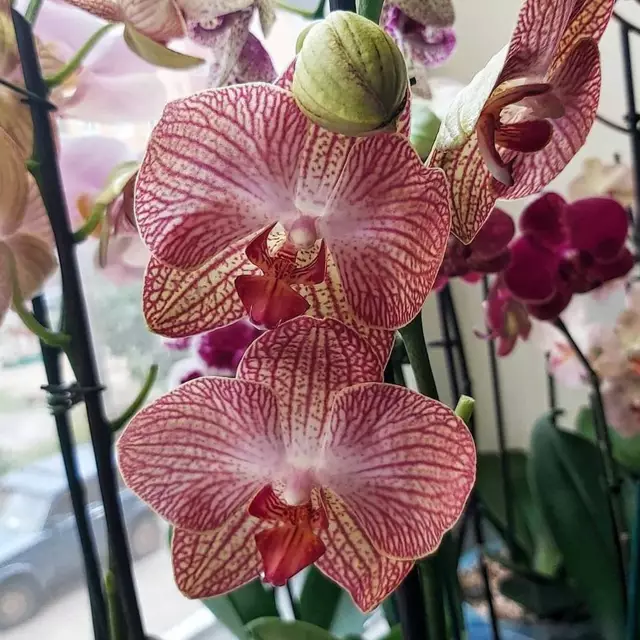 Hybrid epiphytic unpretentious variety. Yellow, peach and pink color is prevalent in nine-centimeter flowers, located on tall peduncles.
Hybrid epiphytic unpretentious variety. Yellow, peach and pink color is prevalent in nine-centimeter flowers, located on tall peduncles.
Phalaenopsis Victorio (Phalaenopsis Fontano Victorio)
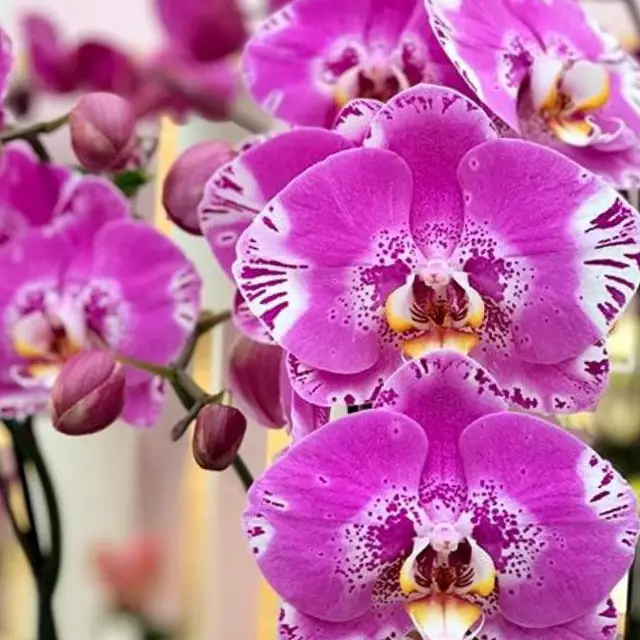 An interesting hybrid variety that has compact leaf plates and large flowers.
An interesting hybrid variety that has compact leaf plates and large flowers.
Phalaenopsis Ark's Ray
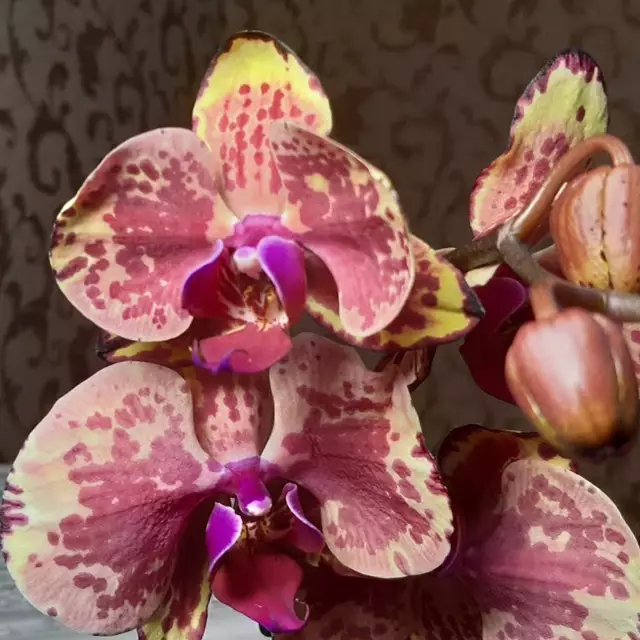 Gorgeous hybrid fruitful orchid in bloom. Large flowers reach a ten-centimeter size.
Gorgeous hybrid fruitful orchid in bloom. Large flowers reach a ten-centimeter size.
Phalaenopsis Violet Queen
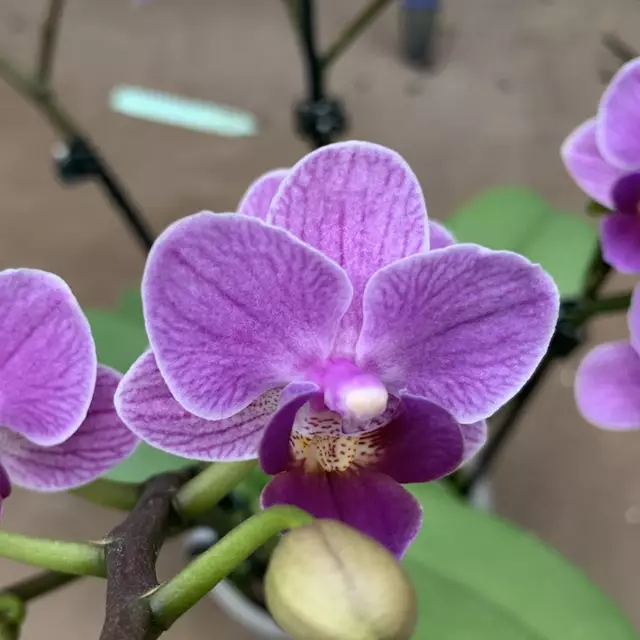 Miniature flowers with rounded lilac velvet petals and a dark purple lip, which has a yellow base and a white column. This perse palette of colors makes the flower unique.
Miniature flowers with rounded lilac velvet petals and a dark purple lip, which has a yellow base and a white column. This perse palette of colors makes the flower unique.
Phalaenopsis Zambia
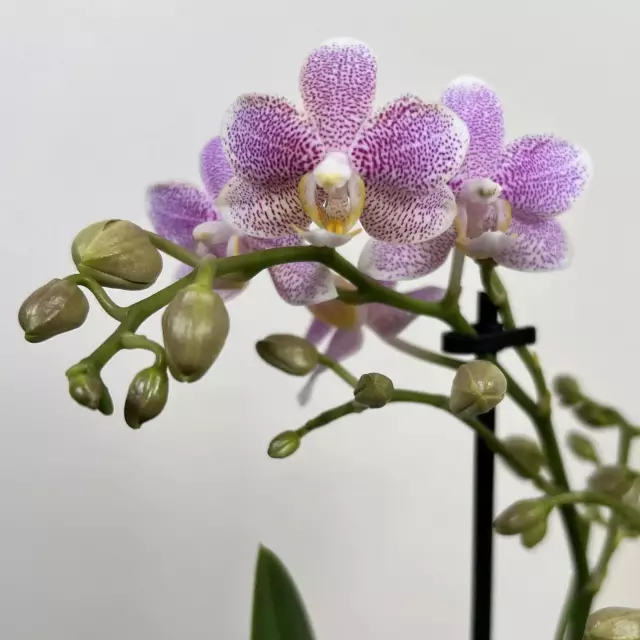 A multifloral orchid variety with abundant, elegant flowering with the most delicate lilac flowers. This beauty fills the air space around with a light floral scent.
A multifloral orchid variety with abundant, elegant flowering with the most delicate lilac flowers. This beauty fills the air space around with a light floral scent.
Phalaenopsis Chanella
 A very original Dutch beauty, and the smell emits French perfume.
A very original Dutch beauty, and the smell emits French perfume.
Phalaenopsis Golden Leopard
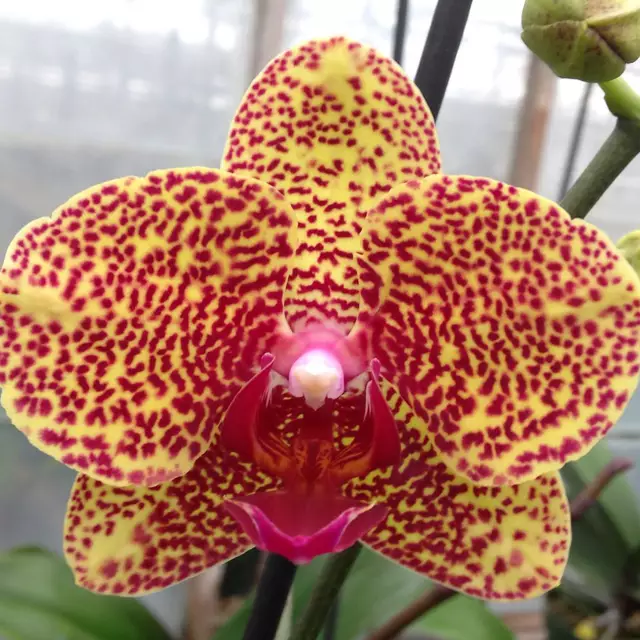 Chic colorful interesting hybrid variety with large flowers and a dark crimson lip. The color of this unpretentious orchid varies from pink tones to peach, and its veins are lilac-blue.
Chic colorful interesting hybrid variety with large flowers and a dark crimson lip. The color of this unpretentious orchid varies from pink tones to peach, and its veins are lilac-blue.
Phalaenopsis home care
The main points of getting the perfect orchid in the right organization of the place for it, regular watering, feeding. Consider the points: how to care for an orchid at home?
Choice of location and temperature
It will be pleasant for the plant on the windows of the western, eastern or northeastern dislocation.
The rays of the bright sun must be shaded.
Favorable for a flower, the temperature range is 10-25 °.
Humidity and watering
Moderate air humidity within forty percent will be comfortable for the growth and flowering of orchids.
Good ventilation in the room must be ensured.
How often should I water my Phalaenopsis orchid? For this procedure, clean soft water at room temperature is suitable. The frequency of watering depends on the condition of the soil in the flowerpot. It should be slightly dry. Approximate watering interval is once every three days.
Avoid getting water on the leaf plates.
Once a month, an orchid can be bathed in the shower.
Soil and its top dressing
The main component of the soil mixture is pine bark. You can add peat and moss. For orchids, the substrate can be purchased at the store.
Top dressing of a room orchid is carried out during watering, adding a complete complex fertilizer. Top dressings intended for orchids will be suitable for phalaenopsis.
Phalaenopsis transplant
To get a beautiful flowering houseplant, you need to know exactly how to transplant phalaenopsis? It is not worth parting with orchid transplants, because for her this procedure is not pleasant. The reason for the transplant may be a small flowerpot or the condition of the substrate wants to be the best. Is it possible to transplant phalaenopsis during flowering? Can. If the plant is susceptible to diseases or pests. But there are also negative points: the orchid may stop growing, the flowering period may be reduced, even the death of the flower is possible. It is necessary to replant the bush with caution in order to avoid negative phenomena. Phalaenopsis care after purchase does not include a mandatory transplant procedure.
How to propagate phalaenopsis?
You can propagate phalaenopsis with the help of children, cuttings and a section of the outlet.
How to grow an orchid from a peduncle? The flowering period ends with the fall of dried flowers. After that, the flower-bearing arrow acquires small plants - children. The cut peduncle is immersed in a bottle of water seven centimeters. Satisfy the conditions of the mini heifer, using a plastic bag, you need good lighting. Separating the grown children, we root and get a brand new plant.
How to grow an orchid from a leaf at home? The Phalaenopsis orchid is practically not grown from a leaf.
Pests and diseases
With flaws and miscalculations in the care of phalaenopsis, spider mites, thrips, scale insects, and slugs can satisfy with their presence. Treatment with insecticidal preparations will help the plant get rid of unexpected guests.
Difficulties encountered in growing
- The leaf plates have become pale - the lighting is too bright, the plant may need to be fed with fertilizers.
- The air roots dry out slightly - it is necessary to increase the humidity of the air.
- The leaves have become sluggish - excessive watering is possible.
- The ends of the leaf plates turn black - waterlogging or the presence of a draft is possible.
- Why phalaenopsis does not bloom - the conditions of detention are violated or the plant is sick.
How to care for a phalaenopsis orchid is considered point by point. The main task is to adhere to these recommendations.
Treat your phalaenopsis with love and attention, and they will thank you by decorating the interior for many years. No less interesting varieties of flowers can be seen on the site by opening the catalog of indoor plants from a to z.




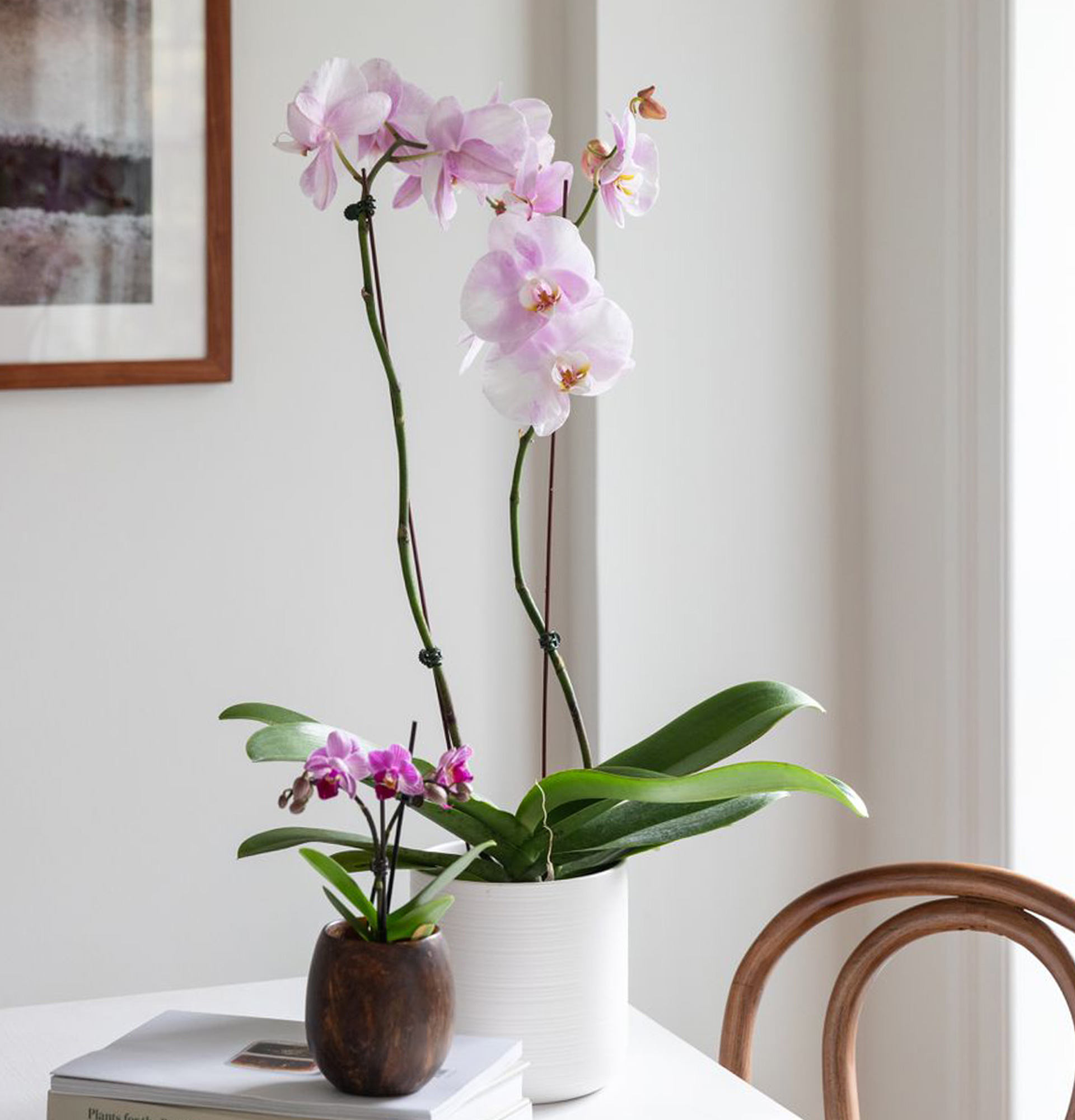










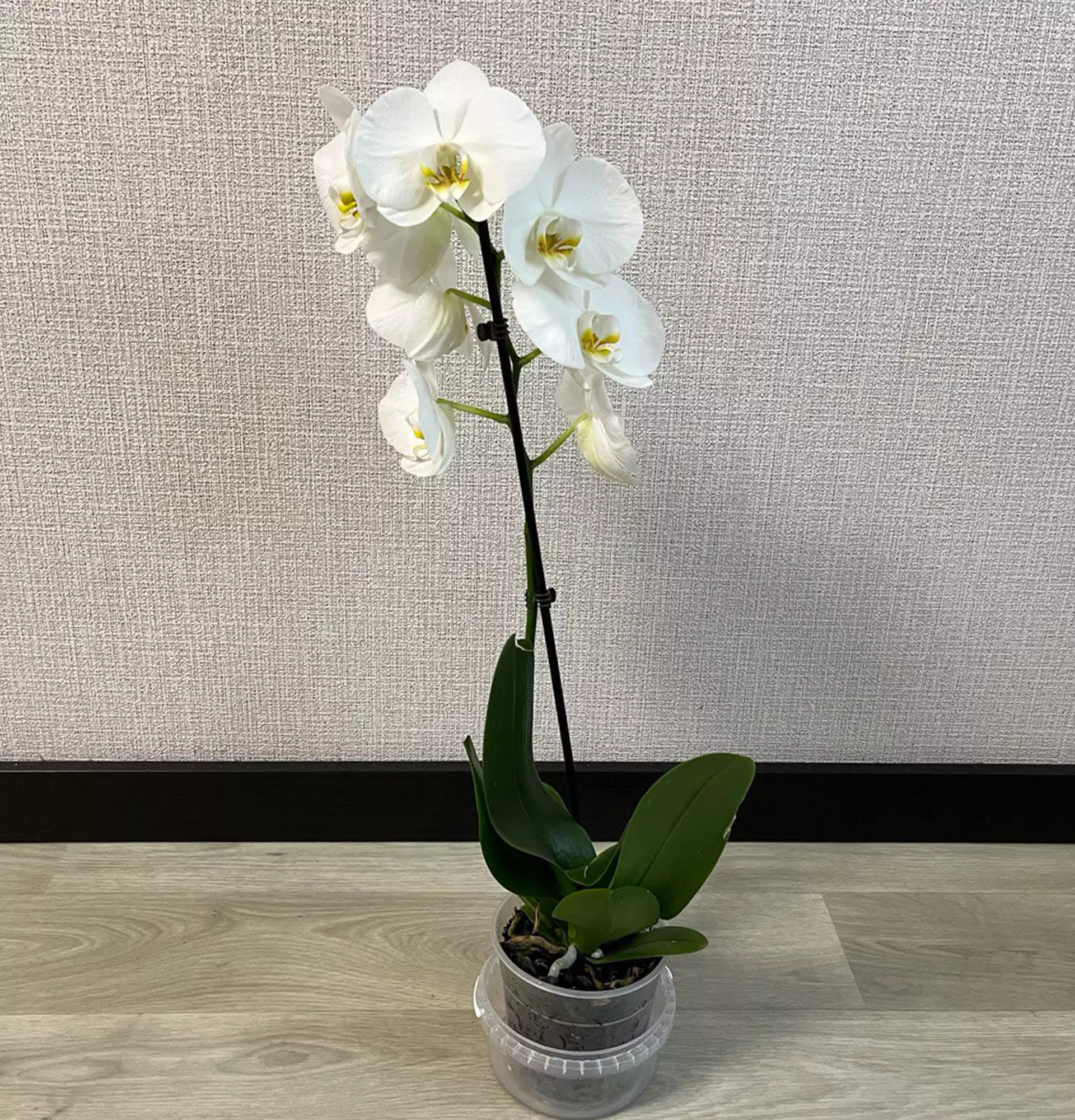

Write comments
Comments